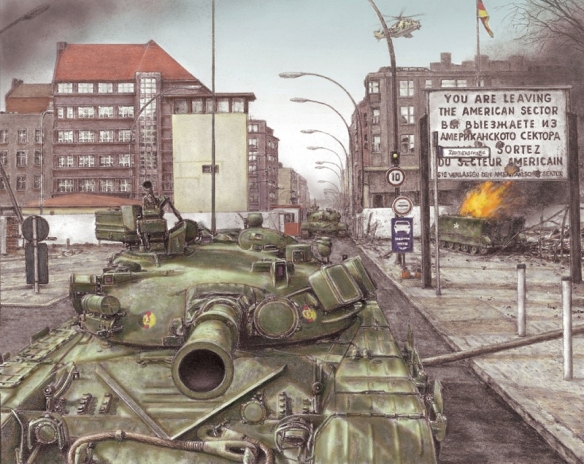The operational plan was code named “THRUST” (German: STOSS). It concerned the occupation of West Berlin “within the scope of preventive actions following prior aggression by NATO outside the Central European area, for example an attack by Turkey on Bulgaria.” Berlin was to be occupied “while NATO was transporting its reinforcements from overseas and before the opening of military operations” along the intra-German and Czechoslovakian-German borders. In 1987, following the introduction of the new Soviet military doctrine, certain changes were made. The plan was re named “CENTER” (German: ZENTRUM), and West Berlin was now to be occupied only “following NATO aggression resulting in the violation of state [East Germany] borders.”
Following the political decision to occupy West Berlin, a “Berlin Group” field command would be formed out of the East German Army High Command, located in Wildpark West near Potsdam. The “Berlin Group” command was to direct over 32,000 East German and Soviet troops in operations against an estimated 12,000 Allied troops and 6,000 West Berlin police men. The equipment levels used in the Border’s Edge 86 exercise would be significantly raised in real operations – approximately 390 tanks, 450 guns and mortars, 400 antitank units, and 400 armored personnel carriers would be committed.
The plans envisioned splitting West Berlin into two sectors. The sector boundary ran from Konradshöhe in the northwest along the Autobahn ring road from Charlottenburg to Schöneberg, ending at Lichtenrade in the south. The area to the west of the divide was designated as Sector I, while that to the east was Sector II. These sectors did not correspond to, and should not be confused with, the British, French, and American occupation sectors. The occupation of Sector I was to be the task of the NVA’s 1st Motorized Rifle Division (minus its 1st Regiment), the 5th Regiment of Frontier Command North, the 34th and 44th Regiments of Frontier Command Central, an assault engineer battalion of the 2d Engineer Brigade, and four battalions of Potsdam’s paramilitary “Combat Groups of the Working Class.” The 3d Regiment of the 1st Motorized Rifle Division, flanked by the 5th Frontier Troop Regiment to its left, was to push from the west along Bundesstraße 5 toward Spandau, where the majority of the British Brigade’s facilities were located. The 34th Frontier Troop Regiment would move out of Kladow in the west toward the British military airport at Gatow. In the southwest, the 44th Frontier Regiment was to roll along Bundesstraße 1, penetrating the American sector at Zehlendorf, while the 1st Armored Regiment thrust directly toward the city center. The 2d Regiment of the 1st Motorized Rifle Division was to move out of Teltow in the south to ward Steglitz, thereby completing the occupation of Sector I.
Sector II, the eastern portion of West Berlin, would be occupied as follows: The Soviet 6th Independent Motorized Rifle Brigade, part of the Soviet Group of Forces in Germany, would roll past the Brandenburger Gate, proceed down the Avenue of the 17th of June to Ernst Reuter Plaza, and continue down Bismarck Street until it reached the Kaiserdamm Bridge. The 18th People’s Po lice Alert Unit and the 33d Frontier Troop Regiment were to provide flank protection. The 1st Regiment of the 1st Motorized Rifle Division would assault out of Pankow toward Tegel International airport, while the 38th and 40th Frontier Troop Regiments occupied Reinickendorf, part of the French sector. The 35th, 39th, and 42d Frontier Troop Regiments would close in on Neukölln and Kreuzberg, areas within the American sector. Support for these assaults would be provided by the 40th Artillery Brigade, an assault engineer battalion of the 2d Engineer Brigade, and propaganda detachments.
The two major assault thrusts, one from the east and one from the west, were to meet at the Kaiserdamm Bridge near Radio Free Berlin, thereby cutting the city in two. Tegel airport, in the French sector, was to be captured by two airborne companies while Tempelhof Airport in the American sector was to be captured by another. The 1st Battalion of the 40th Air Assault Regiment and parts of 34th Helicopter Transport Squadron would provide the necessary forces. Reserve forces included the 40th Security Battalion, the 19th People’s Police Alert Unit, and four battalions of the (East) Berlin “Combat Groups of the Working Class.” The 40th Signal Battalion was tasked with providing reserve assets for all communication requirements.
Any military worth its salt has prepared contingency plans for operations following the outbreak of war. The Soviet Union and its satellites always claimed that both the structure and planning of the Warsaw Pact revolved around a commitment to defeat the enemy on his own territory following enemy aggression. The initial scenario in the Border’s Edge exercises postulated aggression by NATO, provoking a countermeasure by the Warsaw Pact. Former NVA officers stand by the essentially defensive nature of Pact offensive plans. Yet oddly, little attention is paid to containing and defeating NATO offenses. In fact, East German intelligence evaluations concluded that NATO forces in West Germany lacked the structure and equipment for deep offensive operations in the eastern direction. In short, taken at face value, the NVA laid meticulous plans for execution of an operation for which the officially proclaimed premise, aggression by NATO, was evaluated as unlikely at best.
Operation Stoss – After Action Report
East German Attack Plans for World War 3
